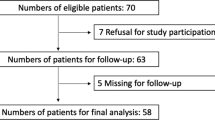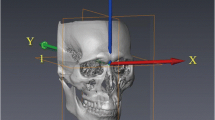Abstract
Purpose
When improving jaw deformity by two-jaw surgery, we are of the opinion from our clinical experience that a certain degree of undercorrection is occasionally beneficial from the perspective of stability. Functional deterioration is not always seen with undercorrection. We conducted this retrospective study to assess post-operative stability in patients with facial asymmetry, with the aim of both clarifying differences between the original three skeletal class patterns, and confirming the efficacy of surgery performed on the basis of our concept.
Patients and Methods
All patients received optimal orthognathic treatment before and after surgery. Surgery was performed by our concept that undercorrection is not always bad. Nineteen patients were enrolled, and separated into three skeletal classes according to the ANB angle, because of the difference of the treatment modalities between them. Evaluations were performed by cephalometric measurements taken at least two-year post-operatively. Transverse occlusal cant, chin deviation, point A, point B, overjet and overbite were assessed.
Results
In all patients, transverse occlusal cant improved to <4°, which has been reported as the threshold for visual recognition of facial symmetry. Chin deviation was also improved to the degree at which soft tissue can sufficiently mask the asymmetry. The changes remained stable throughout follow-up and satisfaction was obtained from all patients.
Conclusions
Irrespective of original skeletal class patterns, post-operative stability of patients with facial asymmetry was achieved. Undercorrection is thus by no means problematic from the clinical perspective of stability and our concept of approach appears valid.










Similar content being viewed by others
References
Bevis RR, Waite DE (1980) Maxillary asymmetry. In: Bell WH, Proffit WR, White RP (eds) Surgical correction of dentofacial deformities. PA, W. B. Saunders, Philadelphia, pp 1524–1569
Matsushita K, Inoue N, Totsuka Y (2011) In vitro biomechanical evaluation of the effect of an additional L-shaped plate on straight or box plate fixation in sagittal split ramus osteotomy using a bioabsorbable plate system. Oral Maxillofac Surg 15:139–146
Proffit WR, Turvey TA, Phillips C (2007) The hierarchy of stability and predictability in orthognathic surgery with rigid fixation: an update and extension. Head Face Med 3:21–31
Gardner SD, Chaconas SJ (1976) Posttreatment and postretention changes following orthodontic therapy. Angle Orthod 46:151–161
Riedel RA (1960) A review of the retention problem. Angle Orthod 30:179–199
Williamson EH, Simmons MD (1979) Mandibular asymmetry and its relation to pain dysfunction. Am J Orthod 76:612–617
Lu KH (1965) Harmonic analysis of the human face. Biometrics 21:491–505
Ellis E (2007) A method to passively align the sagittal ramus osteotomy segments. J Oral Maxillofac Surg 65:2125–2130
Padwa BL, Kaiser MO, Kaban LB (1997) Occlusal cant in the frontal plane as a reflection of facial asymmetry. J Oral Maxillofac Surg 55:811–816
Ferrario VF, Sforza C, Colombo A, Miani A Jr, D’Addona A (1993) Position and asymmetry of teeth in untreated dental arches. Int J Adult Orthodon Orthognath Surg 8:277–285
Conflict of interest
The authors declare that they have no conflict of interest.
Author information
Authors and Affiliations
Corresponding author
Rights and permissions
About this article
Cite this article
Matsushita, K., Inoue, N., Yamaguchi, Ho. et al. Post-operative Stability After Bimaxillary Surgery in Patients with Facial Asymmetry: Comparison of Differences Among Different Original Skeletal Class Patterns. J. Maxillofac. Oral Surg. 14, 789–798 (2015). https://doi.org/10.1007/s12663-014-0713-x
Received:
Accepted:
Published:
Issue Date:
DOI: https://doi.org/10.1007/s12663-014-0713-x




